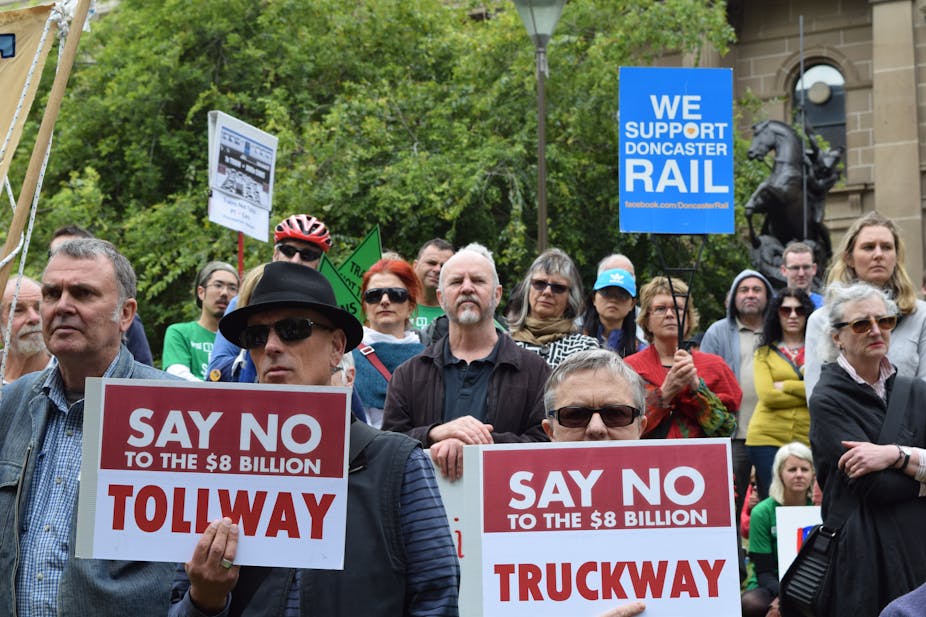Victoria’s public-private partnerships (PPPs) are a mess. Their democratic standing has never been lower. They have always trumpeted better value for money and more timely delivery, but with the contract for the estimated $17.8 billion East West Link about to be “ripped up” it now looks more like a circus.
Few winners will emerge from the coming fight. Though incoming Labor Premier Daniel Andrews should be applauded for planning to release the East West contract, the deadline for doing so has long past.
Details reportedly to be released today will allow Victorians to judge whether their political leaders and bureaucrats have been stewards of the public’s interest or been lubricating the business gravy train.
Amidst government cutbacks, $250 per head dinners between public servants and the project’s financiers certainly appears to the public like snouts in the trough. The real issue here, however, is not the East West project itself, but how it is a symptom of a much larger problem.
Infrastructure policy and debates around PPPs are inherently political. While citizens tend to dismiss politicians as hopeless, governing in the public realm is actually a tough job. It is also probably more complex and difficult now than it has ever been.
An ‘expectations gap’ for infrastructure projects
Australian governments are increasingly constrained by existing financial outlays and policies. They also face highly skilled interest groups and the public’s increasing expectations in a hungry media cycle.
In reality, there is an increasing “expectations gap” between what is promised or expected and what can realistically be delivered by politicians.
Developing big infrastructure projects will always be controversial. However, current infrastructure debates are leaving the cabinet table and banking boardrooms and entering the kitchens and supermarkets. Citizens rightly have strong opinions on PPPs. The government may well have behaved legally, despite a number of court challenges, in regards to the East West link, but we expect more. We expect legitimate democratic decisions and transparency around how the government has been acting on our behalf.
Under private contract law, governments can decide what is secret and what is not, what financial returns work for the private sector and what do not. Many governments and bureaucrats have also invested huge political capital in the PPP brand.
PPPs allow governments to focus on the short-term gain
Victoria is now one of the world’s leading proponents of PPPs. It has lots of showpiece projects including the $5.7 billion desalination plant and $2.5 billion Eastlink road. The PPP idea is to create a long-term private finance arrangement and bundle many smaller contracts and multiple firms into one consortium deal.
This is despite history suggesting these structures can lead to cash windfalls for smart financial executives while public benefits are left languishing to the long-term. More importantly, PPPs help deliver short-term gains to politicians eager to provide visible big infrastructure projects to an expectant public. I acknowledged a decade ago that PPPs play an immediate political role.
They help governments set the public agenda and put infrastructure funding at the forefront of political debate; they help get projects implemented; and they help crash through existing policy settings. So at a time when the business of government around the world has become more difficult, long-term infrastructure contracts put governments back in the driver’s seat. It is little wonder that many politicians join the PPP cheer squad.
While PPPs are in one sense politically successful for project delivery, they remain to my mind, financially and democratically dubious. As the UK Public Accounts Committee warned, “PFI deals look better value for the private sector than for the taxpayer”.
Transport projects which lack economic sense are wasteful, too. Several years ago I labelled Victoria’s private finance deals “the illegitimate child of the PPP infrastructure family”.
I have also argued for governments to move from their standard private finance model and experiment with new arrangements to get a better deal for citizens. My voice was drowned out by those of consultant advisers and technocrats.
It is great to see debate in many countries now increasingly turn away from pseudo-technical contests around PPP performance and addressing more fundamental issues of legitimacy and political power. PPP contracts are being acknowledged as a primary long-term governing tool not just a temporary project delivery mechanism.
The United Kingdom is also facing similar PPP issues. In 2012, the UK Treasury acknowledged widespread concerns that taxpayers had “not been getting a fair deal now and over the longer-term”.
So where should Victorian PPP policy go to from here?
We need more “partnership” options to be put on the table. There are thousands of different ways to shape long-term PPP contracts, despite Victoria’s strident belief that its particular approach is the “one best way”. State borrowing for projects should also be considered.
There needs to be some new policy experiments in public finance and capacity building. Infrastructure bonds are a great idea. Another option is to benchmark unit costs across different delivery options and publish these results for peer review. Governments need to stop telling us how good PPPs are and show us.
This involves greater transparency where our Auditor-General can follow the money trail and publishing PPP contracts with all their inconvenient details. A more consistent infrastructure prioritisation process also needs to be established.
If we want new infrastructure in Australia that is worthwhile and legitimate, we need better ideas than secret contracts and politicians influenced by private capital and high-priced dinners. We need them urgently.

